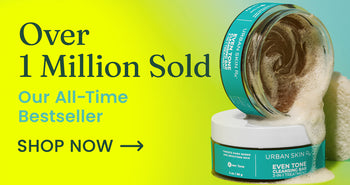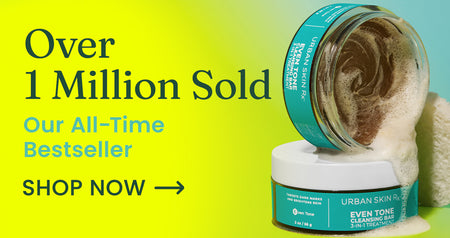Does Hyperpigmentation Ever Go Away?

The struggle is real if hyperpigmentation is a part of your life. Hyperpigmentation can be brought on by several different conditions and triggers and can get in the way of that “you just woke up like this” glow you may have been used to before dark spots and blemishes cast a shadow over it.
While there are many recommendations for improving the look of hyperpigmentation, you may not be having much luck. And if your hyperpigmentation is recurring, you might be wondering…Does hyperpigmentation ever go away? Unfortunately, there isn’t a straightforward answer to this question, so let’s get to the bottom of it.
What Is Hyperpigmentation?
Hyperpigmentation occurs when melanin builds up in some regions of your skin and causes dark marks or spots. Hyperpigmentation can affect the outer tissue layer of your skin, or it can go deeper, the latter of which is harder to treat. Because melanin production is already higher in people with deeper complexions, people of color are more likely to struggle with hyperpigmentation.
While hyperpigmentation can be brutal to your self-esteem, it, fortunately, isn’t dangerous to your health. It’s more of a cosmetic issue than anything else! However, as with any abrupt change in your complexion, it’s worth paying your doctor or dermatologist a quick visit to make sure that your hyperpigmentation is, in fact, hyperpigmentation and not something more concerning.
What Causes Hyperpigmentation?
Many different conditions can bring on hyperpigmentation! That’s why it’s essential to visit your doctor or dermatologist to help get you on the right road to recovery, even if treatments for different types of hyperpigmentation tend to be pretty similar.
One fairly common cause of hyperpigmentation is Melasma. Melasma mostly appears on your face and along your jawline, although you can get it in other places as well. Annoyingly, Melasma appears mostly in areas often exposed to the sun, so it can be difficult to conceal if it’s something you want to downplay. Unfortunately, we don’t know what causes it, although some common triggers include hormonal changes. So if you’ve noticed hyperpigmentation during pregnancy, after switching birth controls, or after prolonged sun exposure, you’re probably dealing with Melasma.
Another usual suspect when it comes to dark marks is Post-Inflammatory Hyperpigmentation. PIH occurs after your skin has been injured or irritated, causing hyperpigmentation to form around the affected area. So, for example, if you have a horrible acne breakout and you didn’t quite resist picking at it, you could end up with a bout of hyperpigmentation even after the acne clears up.
Hyperpigmentation can also start to crop up as you age. Sunspots or liver spots are other well-known types of hyperpigmentation that occur after spending years and years exposed to UV rays. You can end up with these marks even if you’re a religious sunscreen user — although it does help cut down on the adverse effects of sun exposure! — so there’s no shame in it. It’s just a part of life.
How Can You Prevent Hyperpigmentation?
Preventing hyperpigmentation is much like preventing any other skin problem. One major step toward prevention is a consistent and comprehensive skincare routine so that your skin has the fortification it needs to resist certain factors and keep adverse effects from building up over time.
You probably get this if you struggle with acne! While treating your breakout with a Clear Complexion Acne Serum and Spot Treatment can help you win that battle as it happens, in the war against problem skin, the real solution to recurring issues like blemishes (and hyperpigmentation!) is consistency and prevention.
One of the best ways to keep dark spots from ruining your next selfie or getting darker is to wear sunscreen every single day. Remember, just because it’s raining or cloudy out doesn’t mean there aren’t harmful UV rays making their way down to you.
It’s also important not to fall into the trap of thinking that you’ll only be outside while walking between places or only for a little bit. Protecting your skin against even the slightest exposure to the sun can make a big difference in the long-term appearance of your skin. And because conditions like Melasma and Post-Inflammatory Hyperpigmentation are often triggered by sun exposure, this goes double if you’re trying to avoid hyperpigmentation.
Another easy — yet sometimes, surprisingly tricky — way to protect your skin from hyperpigmentation is to avoid touching it! This is especially important for problems that can lead to hyperpigmentation, like breakouts. It’s so tempting to pick at or pop your pimples — but unless you’re a serious pro or are being overseen by one, it’s best to leave them alone!
The golden rule of not touching your face also applies to things like applying makeup or lotion. Make sure you wash your hands first. Otherwise, you can get the usual dirt and grime you accumulate throughout your day onto your skin and into your pores, clogging things up and irritating things. So hands off!
How Can You Improve the Look of Hyperpigmentation?
Most forms of hyperpigmentation can be improved. While treatment isn’t necessary for medical reasons, it can be a huge relief to finally improve the appearance of stubborn hyperpigmentation for you and your ego.
There are several ways you can address your hyperpigmentation, but we always recommend that your first step is to visit a doctor or dermatologist. While you can probably learn a lot of what you need to know about hyperpigmentation treatments from trusted sources on the internet or in your life, no one knows better than a professional.
But once you’ve done that, there’s a wealth of potential treatments available for you to try out!
Retinols or Retinoids
While Retinols are probably best known for their effectiveness when it comes to lessening the visible signs of aging and giving your skin a brightening boost, they’re super helpful when it comes to treating hyperpigmentation as well.
Retinols and Retinoids are Vitamin-A-based ingredients that give your body a boost of exfoliation to bring more youthful-looking skin to the surface, leaving your skin feel refreshed and glowing. That makes these ingredients great for improving the look of hyperpigmentation because they help on a deeper level than just restoring the surface of your skin.
Retinols and Retinoids are also great because they don’t just help with hyperpigmentation. After your skin gets accustomed to them, they also won’t cause skin damage if you use them long-term. Thus Retinols and Retinoids can be used for both treatment and prevention once your hyperpigmentation clears up.
Skin Brightening Ingredients
Ingredients like Hydroquinone and Cysteamine are superheroes for improving the look of hyperpigmentation. Cysteamine generally comes as a cream, and it helps to fight the look of discoloration, which in turn reduces the look of pigment that presents on the surface of your skin.
Hydroquinone is also a highly effective ingredient for improving the appearance of hyperpigmentation and dark spots.
Hydroquinone and Cysteamine can be very effective in reducing the appearance of dark marks. However, they usually take a few weeks to work and can be a bit rough on your skin. So you’ll want to be sure you’re following your doctor or dermatologist’s instructions to a T. It’s also essential to keep your skin hydrated while you’re using skin brightening agents! (Or anything that might be rough on your skin.)
Chemical Exfoliation
Another common way to improve the look of hyperpigmentation is by using chemical exfoliants. Chemical exfoliants work by clearing the way for skin cell renewal to help resurface your skin. It’s similar to the effect of a typical, abrasive exfoliant but can be even more effective.
Working our Clear and Even Tone Clarifying Glycolic Pads into your skincare routine can help to improve the appearance of dark marks and other blemishes. You’ll want to use them after cleansing but before moisturizing.
If you’re in the market for something that hits a little harder, a DIY chemical peel like our Even Tone Resurfacing at Home Peel Pads is a great option. A chemical peel will go deeper, faster — but it’s also a great option if you’re just not looking to add something to your daily routine. It’s also possible to get professional chemical peels from a certified professional, which come in varying strengths. So if you’re looking for a significant improvement to the look of your hyperpigmentation, it might be worth investigating.
So… Does Hyperpigmentation Go Away?
Unfortunately, the answer to this isn’t a straight yes or no across the board. As we’ve pointed out, there are many different ways to reduce the look of hyperpigmentation and dark marks — but not every treatment will work for every person or every type of hyperpigmentation.
Some hyperpigmentation will just fade or disappear with time, whether or not you attempt to attack it head-on. But some hyperpigmentation may just be a new norm. While this might be disheartening if you’re frustrated with the appearance of your dark marks and blemishes, don’t give up hope!
It’s possible you just haven’t found the correct answer yet. And even if your hyperpigmentation is here to stay, many cosmetics will help you disguise it if that’s what you want. Of course, it’s also totally fine to simply embrace your uneven skin tone.
In Conclusion
There are many different ways to confront hyperpigmentation. It doesn’t always fade or disappear, but whether or not your dark marks are on their way out or permanent parts of you, there are still many ways to get your glow on.Service Representative



